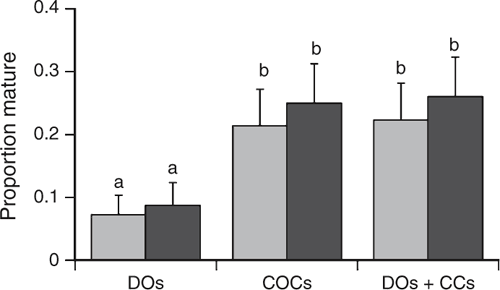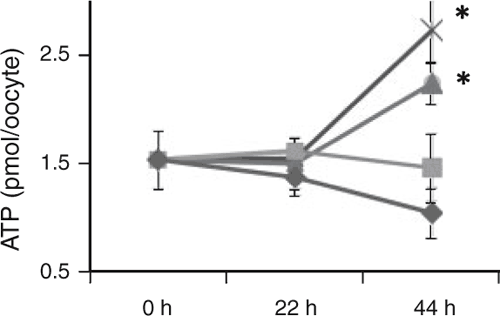The influence of cumulus cells on porcine oocyte maturation in the presence of L-carnitine
A. N. Steel A C , J. L. Lowe A , T. Somfai B and C. G. Grupen AA The University of Sydney, Camden, NSW 2570.
B NARO Institute of Livestock and Grassland Science, Tsukuba, Ibaraki, Japan.
C Corresponding author. Email: alicia.steel@sydney.edu.au
Animal Production Science 55(12) 1507-1507 https://doi.org/10.1071/ANv55n12Ab062
Published: 11 November 2015
Porcine in vitro maturation (IVM) enables large numbers of oocytes to be salvaged from ovarian follicles and cultured in vitro to a stage at which they are capable of facilitating fertilisation and subsequent embryonic development. However, resultant embryos have reduced viability compared to those produced in vivo (Kikuchi et al. 2006). The relative contributions of carbohydrate and lipid metabolism during IVM and the effect of cumulus cells on lipolysis are still poorly understood. The objective of this study was to determine the influence of cumulus cells on porcine oocyte maturation in the presence of L-carnitine (LC), a lipid metabolism stimulant, under reduced carbohydrate conditions. It was hypothesised that the LC treatment would increase cellular energy generation, thereby improving the maturation of oocytes.
Cumulus-oocyte complexes (COCs) were recovered from 3–6 mm follicles of abattoir-derived ovaries, and either kept as intact COCs or denuded of their cumulus cells (CCs). Groups of COCs and denuded oocytes (DOs) were matured separately or co-cultured together to assess any indirect influence of CCs (DOs + CCs). Modified porcine oocyte medium (POM; Yoshioka et al. 2008) containing a low concentration (1.5 mM) of glucose and no pyruvate and lactate was supplemented with either 0 or 12 mM LC. Nuclear maturation was assessed at 44 h of IVM. The intra-oocyte concentration of ATP was also measured in oocytes in the presence (+PL) and absence (-PL) of pyruvate and lactate at 0, 22 and 44 h. Data were analysed using ANOVA and Fisher’s unprotected lease significant difference test (Genstat, 16th Edition; UK).
Supplementing LC had no significant effect on the proportion of oocytes that were mature at 44 hours (Fig. 1). As expected, significantly greater proportions of oocytes cultured in the presence of cumulus cells were mature when compared to DOs. An interaction was observed between time and treatment on the ATP concentrations observed per oocyte (Fig. 2). Mean ATP concentrations were increased (P < 0.05) in oocytes matured in the presence of pyruvate and lactate for 44 h compared to all other treatments across all time points. The results indicated that under low carbohydrate conditions LC does not enhance oocyte nuclear maturation, irrespective of the presence of CCs, nor does it significantly increase ATP production. Thus, the hypothesis that LC treatment would improve oocyte maturation by increasing cellular energy generation was rejected. Further studies are required to elucidate whether cumulus cells play a role in porcine oocyte lipid metabolism.

|

|
References
Kikuchi K, Nakai M, Shimada A, Kashiwazaki N (2006) Journal of Mammalian Ova Research 23, 96–106.| Crossref | GoogleScholarGoogle Scholar |
Yoshioka K, Suzuki C, Onishi A (2008) The Journal of Reproduction and Development 54, 208–213.
| Crossref | GoogleScholarGoogle Scholar |


 0 mM and
0 mM and  12 mM LC. Different letters indicate differences between treatments (P < 0.05). Denuded oocytes (DOs), cumulus-oocyte complexes (COCs), cumulus cells (CCs).
12 mM LC. Different letters indicate differences between treatments (P < 0.05). Denuded oocytes (DOs), cumulus-oocyte complexes (COCs), cumulus cells (CCs). +LC/+PL,
+LC/+PL,  -LC/+PL,
-LC/+PL,  +LC/-PL,
+LC/-PL,  -LC/-PL). Values with an asterisk are significantly different (P < 0.05).
-LC/-PL). Values with an asterisk are significantly different (P < 0.05).